Setting the Table: Where Fashion Meets Food
Exploration into how food and fashion are merging in modern brand storytelling.
I recently attended an event in Brooklyn where butter quite literally took center stage. The product in focus? A Freja bag in a sumptuous, butter-hued leather. But beyond the accessory, the dinner itself (curated by Chef Rasika Venkatesa) was a masterclass in sensory storytelling. From freshly baked sourdough loaves used as edible centerpieces to butter dishes reimagined as dessert plates, every detail was thoughtfully composed to blend taste and texture with aesthetic delight. It was all brought to life by my dear friend Angelina, founder of MOSA, whose eye for art direction and hospitality made the night one to remember.
That evening left me wondering: why does it feel like fashion and food are more intertwined than ever before?

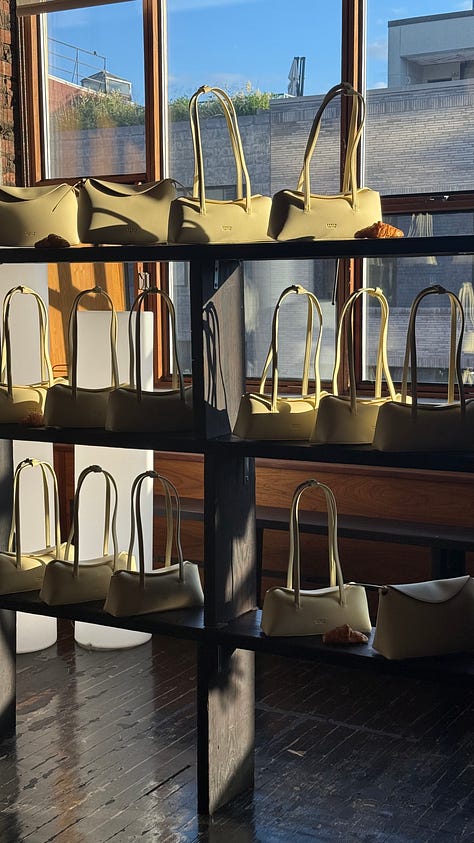
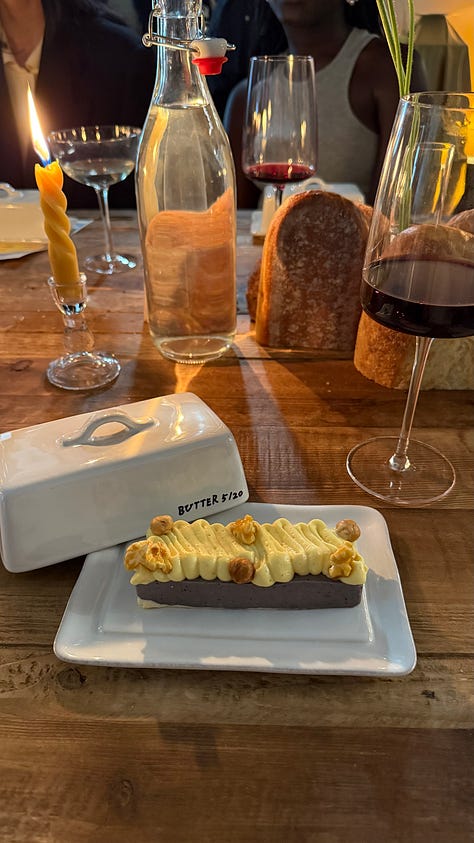
Lately, I've noticed a clear uptick in the ways fashion borrows from food across editorials, immersive experiences, and even in the garments themselves. From campaigns styled so well you want to eat them, to designs that evoke flavor and texture, brands are embracing the full spectrum of sensory marketing. And it’s not just clever content. These layered, tangible experiences are shaping the emotional core of brand identity. They aren’t just selling products, they’re serving stories.
Historical Appetizer: When Taste Became Symbol
Is fashion’s fascination with food new? Not quite. While we’re currently in a moment of experiential maximalism, the dialogue between the two has long been ripe with symbolism, seduction, and subversion.
Consider Salvador Dalí, the surrealist master of deliciously disorienting imagery. When I discovered he had written a cookbook, Les Dîners de Gala, I had to track it down. Known for his obsessions with Freud, food, and eroticism, Dalí believed both sex and cuisine stimulated the subconscious. Lobsters, in particular, recurred throughout his work. To him, they weren’t just crustaceans they were aphrodisiacal symbols. Their hard shells, soft interiors, and exaggerated forms echoed themes of indulgence and repression, desire and danger.
It’s no coincidence that one of the most iconic moments in fashion history involved a lobster.
In 1937, Dalí collaborated with Elsa Schiaparelli to create the “Lobster Dinner Dress,” a pristine white silk organza gown emblazoned with a bold red lobster printed across the skirt. The placement was no accident, both suggestive and shocking. At a time when women were expected to be modest, this dress served as a rebellious statement. Schiaparelli blurred the line between garment and art, teasing conventional fashion norms by embedding sexuality and surrealism into couture. The dress wasn’t just decorative at the time it was disruptive. It invited the wearer (and viewer) to think, to feel, and to reconsider what fashion could say.
By the 1960s, that interplay evolved into Pop Art. Andy Warhol’s Campbell’s soup can didn’t just critique consumerism; it celebrated it. Warhol ate the soup daily as a child. To him it was comfort, nostalgia, Americana. What might seem like a mundane pantry staple became a sacred object, immortalized through repetition. In fashion photography of the era, food imagery from soda bottles, bananas and bubblegum became visual shorthand for appetite, youth, and rebellion.
What ties these moments together is the realization that food and fashion are both mediums of identity. They allow us to project, to express, to indulge.
Editorial Bites: Food as a Visual Metaphor
Foods are increasingly being used in editorials not just as props, but as symbols that suggest mood, energy, and emotion.
Think of a pomegranate. Depending on the cultural lens, it can represent seduction, fertility, wisdom, or transformation. In Greek mythology, Persephone’s consumption of pomegranate seeds tethers her to the underworld—a metaphor for descent, mystery, and cyclical rebirth. In Persian and Islamic traditions, it represents paradise and the lushness of hidden complexity. Its vivid color, ruby shine, and tightly packed seeds all speak of sensuality and richness.
Contrast that with a hot dog. On the surface, it’s unserious, kitschy, quintessentially American. But when deployed in an editorial, especially one shot in New York, it can evoke joy, rebellion, humor. Hot dogs in a fashion sense signal a kind of playful femininity that doesn't take itself too seriously. In this way, even a food as humble as a frankfurter can tell a story about status, nostalgia, or wit.
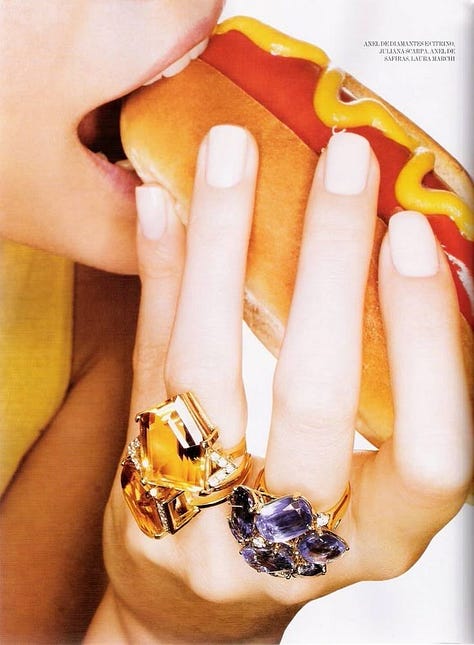
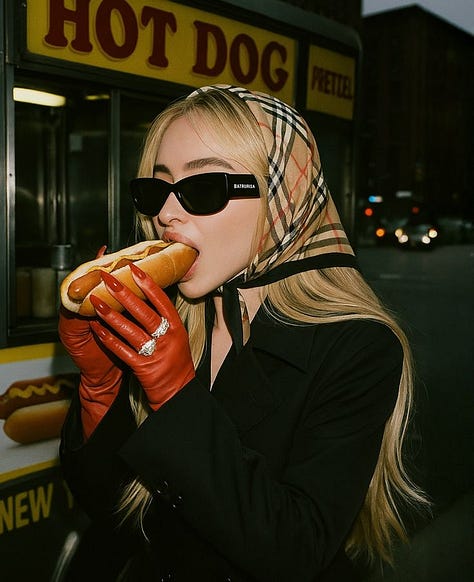
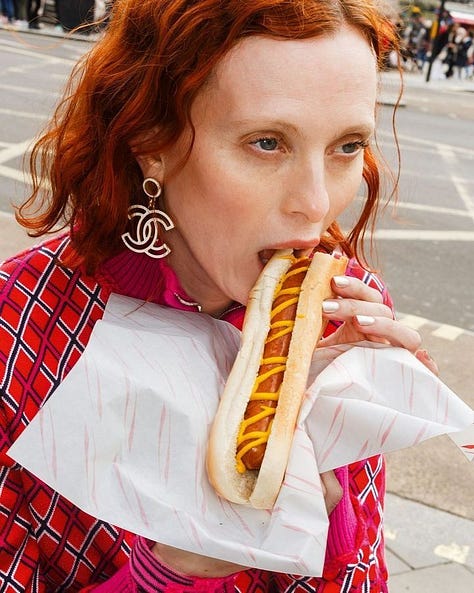
Whether fruit, pastry, or an iconic childhood snack each holds potential cultural resonance. When brands understand this, they can unlock storytelling that resonates across taste, touch, memory, and meaning.
Experiential Meals: Dining as Brand Immersion
My first introduction to the fashion-café phenomenon was in Tokyo. Walk the polished streets of Omotesando or Ginza and you’ll encounter more than luxury flagships. You’ll discover Dior cafes, Gucci restaurants, and Maison Kitsuné coffee counters. In these spaces, cappuccinos are dusted with cocoa CD monograms, and pastries are decorated with brand motifs. You sip from porcelain printed with the same patterns as the latest collection. It’s retail as a ritual, eating your way into the brand.
Are these cafes intended for die-hard customers or for the aspirational fan? The answer is both. It’s democratic luxury. For the price of a $14 latte, you momentarily step inside the dream.
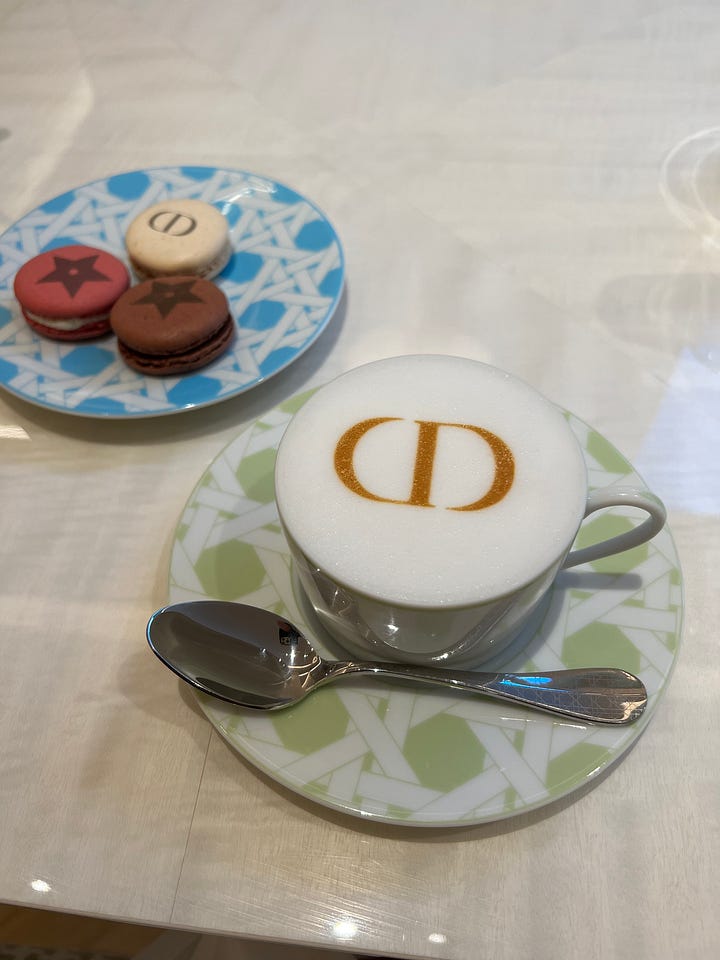
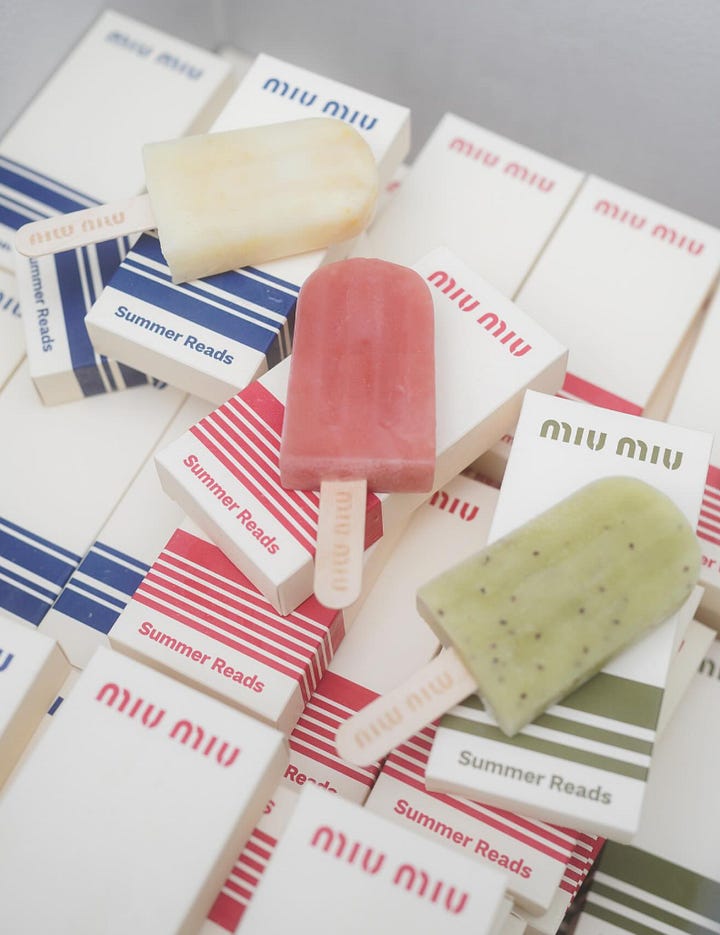
In New York, branded food moments often take the form of pop-ups: a Miu Miu popsicle cart parked outside Casa Magazines. A Chanel diner serving pastel-hued matcha to launch a new fragrance. These activations create not just trending content but also culture. The urgency, the intimacy, the exclusivity all heighten desire.
At Gucci Osteria in Tokyo, I was served a tasting menu that felt more like a runway presentation. Each course had a story; each bite was both nourishment and narrative. The chef played the role of creative director, translating the Gucci world into flavor. Rich brocades became umami-laced sauces. Embroidered flowers turned into edible petals. In that moment, the connection between food and fashion crystallized; it's not just thematic, but visceral.
Product Pairings: Edible Campaigns, Palatable Packaging
Jacquemus might be the modern master of food as branding. Lemons falling from the sky. Banana trucks winding through L.A. streets. Butter on toast as an invitation. The house’s signature yellow is no longer just a color, it’s a flavor, a mood, a memory that sticks.
These playful campaigns don’t just get likes they get remembered. They surprise and delight. They stretch a fashion house’s presence from the closet to the kitchen, from desire to digestion.

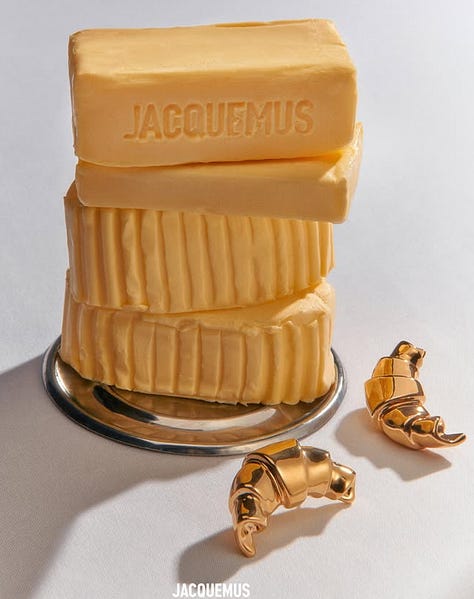
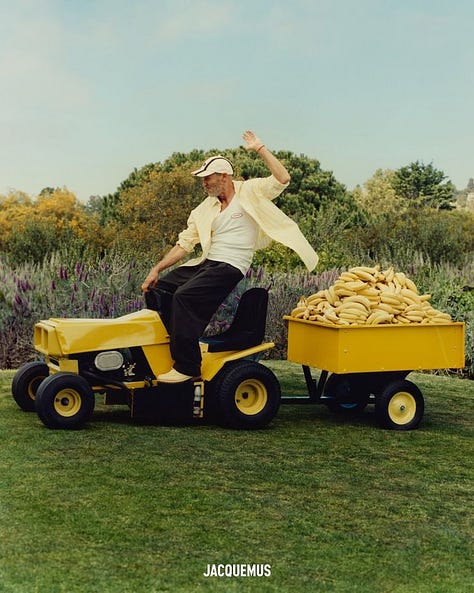
Loewe’s recent tomato campaign took this edible ethos to new heights, literally. What began as a meme, a perfectly ribbed tomato photo so vivid it seemed ripped from a hyperreal produce ad, transformed into a seasonal narrative. The image found itself turned into an opulent clutch, printed onto limited-edition packaging, and even inflated into a full-scale hot air balloon that soared above Cappadocia. Suddenly, the tomato wasn’t just an ingredient. It was a motif, a metaphor, a moment.
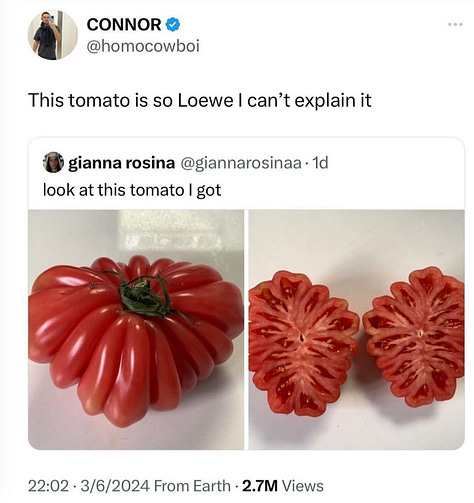
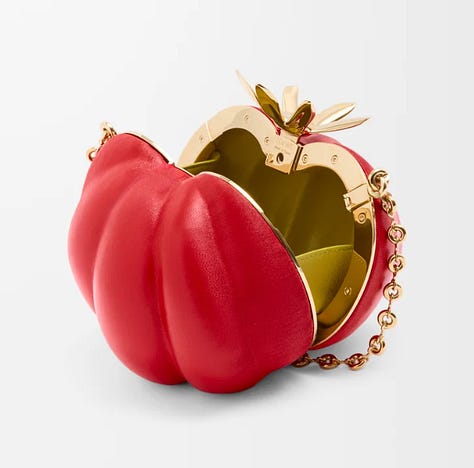
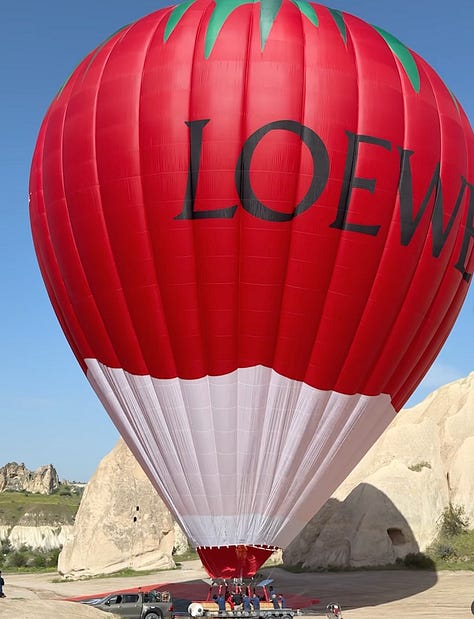
And the sensory layering didn’t stop there. Loewe released a tomato-scented candle, part of its growing home fragrance collection, designed to deepen the brand’s narrative through olfaction. Creative Director Jonathan Anderson explained that he created the scent to "capture the olfactory memories from my childhood." A whiff of green stems, sun-warmed soil, and ripe fruit becomes a portal blending nostalgia, nature, and domestic intimacy into a single inhale.
This is symbolic storytelling at its sharpest: turning the humble tomato into an object of aesthetic reverence. It speaks to ideas of seasonality, sensuality, and even rootedness. In Mediterranean cultures, the tomato is tied to heritage. Loewe recontextualized that cultural richness as luxury without losing the rawness or realness of the original symbol.
Color trends follow a similar path, increasingly flavored by food. Matcha green. Espresso brown. Tomato red. It’s not just “green,” it’s “pistachio,” “sage,” or “avocado.” Food vocabulary lends emotional nuance and sensory association. It helps us feel something. It’s the difference between “pink” and “cotton candy.”
In this new visual and sensory lexicon, foods are more than props; they become portals. They conjure entire aesthetics, evoke memory, and create new categories of taste. In every sense of the word.
The Branding Recipe: Why Food Works for Fashion
So why is this all working?
Emotional resonance is where food and fashion most deeply intertwine. Food is comfort, intimacy, memory such as the taste of your grandmother’s cookies, a late-night slice with friends, the ritual of morning coffee with a lover. Clothes do the same thing. They hold our stories: where we’ve been, who we are, how we want to be remembered. A scent, a shade, a texture, they can all transport us. A silk dress can remind you of a first date just as much as the smell of cinnamon might transport you to your childhood. When brands tap into these emotional echoes through scent, color, or narrative they create more than style; they build connection.
And right now, connection is sensory.
The best brand experiences aren’t just seen; they’re felt. Heard. Tasted. Smelled. It’s butter, not just on toast, but as the visual cue for soft leather. A cherry, not just as fruit, but as a high-gloss red lip. Brands are blurring lines between visuals and physical sensation — translating aesthetics into something we can practically feel on our skin. It’s about evoking desire in every sense of the word. That’s why a great campaign doesn’t end with a swipe — it lingers.
Culturally, it tracks.
We’re living in a moment obsessed with what’s real. Wellness, farm-to-table, slow fashion aren’t just trends, they’re expressions of a deeper craving for authenticity in a world that often feels synthetic. Today’s consumer wants more than product; they want provenance. They want the story. That’s why brands like Bode, Gabriela Hearst, and Loewe feel so relevant. They speak the same language as the farmer’s market: sun-washed, earthy, sensual, slow. Clothes that feel lived in, materials that hold history. It’s fashion as nourishment.
And here’s the brilliance: food is the access point.
Not everyone can buy couture but anyone can eat a croissant stamped with a logo. Food becomes the most democratic entry into luxury. It’s edible branding, palatable desire. And it makes a brand feel not just aspirational, but alive.
Digestif: Taste, Considered
Fashion’s food fixation isn’t just clever, it’s cultural. It’s giving us new ways to connect, to feel, to understand taste as both aesthetic and appetite.
The next time you see a fruit in a fashion spread or sit down at a branded café, ask:
What story is this trying to tell?
What feeling does this evoke?
Is this branding or is it nourishment?
And then, perhaps most importantly: does it satisfy?
Bon appétit.





